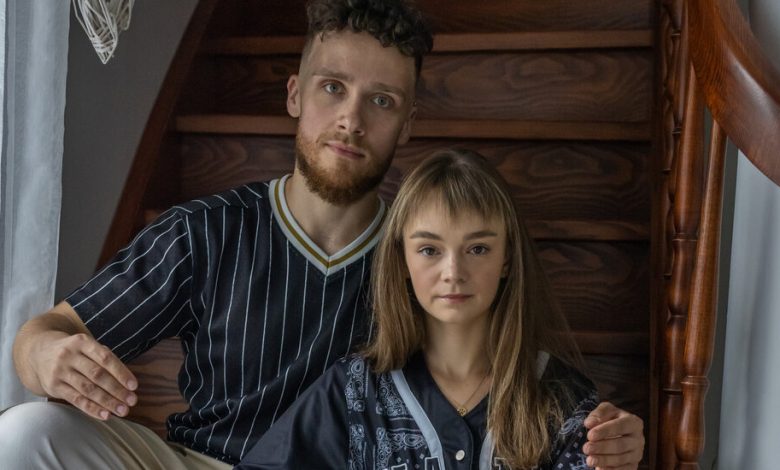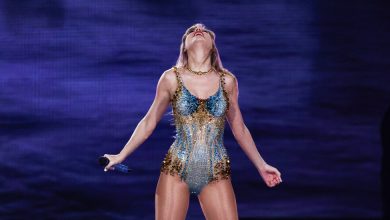Dancers and Video Game Characters Merge in the Uncanny Valley

Watch a TikTok video by @dem_bruddaz, and you might feel a queasy mixture of recognition and disorientation.
You’ll see, say, a person running down a street. But wait — is it a person? Why does he turn at such precise 45-degree angles? Why are his gestures so oddly exaggerated? And is that a Grand Theft Auto theme song playing in the background? Maybe this is a clip from a video game. Or is it some A.I.-generated approximation of a video game?
Though select commenters refuse to believe it, @dem_bruddaz actually are people, the real-life brothers Orlando Murayire, Fernando Shami, Freddy Sheja and Aristide Shema. Based in western France, they’ve built a global following by imitating, with disquieting accuracy, the ambiguously human movements of characters from the video game Grand Theft Auto: San Andreas.
There’s a reason they’re so good at capturing the idiosyncrasies of the game’s animation: They’re dancers, accustomed to identifying and replicating subtle shadings of movement — the kinds of details that make their videos so unsettling.
However unreal the clips seem, making them “feels comfortable to us,” said Shema,who with his brothers grew up immersed in hip-hop, Afrobeat and dancehall. “They just feel like dancing.”
As our screen-filled world seems more like a video game, and sophisticated video games seem more like real life, social media savants have found success with content that deliberately confuses the two. Over the summer, the mainstream internet was both thrilled and flummoxed to discover NPC streamers, creators who earn very real money by repeating the formulaic phrases uttered by video games’ “non-player characters,” or NPCs (“Mmm, ice cream so good”).
But while NPC streaming highlights games’ unnatural speech, dancers are particularly adept at moving like a machine’s version of a human. That helps creators like Shema and his brothers — and the Polish dancers Nicole Hoff and Oskar Szymkowski, who create videos in which they move through the world as NPCs — capture more of what makes video games distinctive, weird and funny. NPC streaming content tends to provoke befuddlement among non-gamers. These dancers’ game parodies, which routinely earn millions of views, are easier for the average viewer to laugh and shudder along with.
Dance has always lived at the center of TikTok, which rode to mainstream popularity on a wave of dance challenges. The video game spoofs aren’t only on TikTok — they’re also found on Instagram and YouTube — and not all of their creators are professional dancers. But Dr. Jessica Maddox, an assistant professor at the University of Alabama who studies social media platforms, thinks that the way they use dancers’ skills ties into a recent shift in TikTok culture.
“To me, these videos hearken back to the fun, silly earlier aesthetic of TikTok that many people seem eager to return to,” Maddox said. It’s a pushback against the once-freewheeling app’s slow march toward slickness and commercialism. “At the same time,” she said, “they obviously take a huge amount of skill and control.” They do silliness with a dancer’s finesse.
It was dance, not video games, that inspired Hoff and Szymkowski, who use the handle @loczniki, to create their first game parodies. As specialists in a style of popping called animation, which mimics the movements of characters from games, movies and cartoons, the duo has experience channeling digital avatars. Their most popular video series imagines what it would be like to have an NPC girlfriend, capturing the strange quirks of non-player characters from The Elder Scrolls V: Skyrim. Hoff and Szymkowski discovered the game when it appeared in their YouTube searches for video game glitches.
“All the mistakes — the character getting stuck somewhere, or walking in one place because there’s a wall — we hadn’t played Skyrim, but we knew those would be funny to imitate,” Hoff said. (After their videos began to go viral, the pair did start playing Skyrim, searching for further inspiration.)
Why do video game avatars move so oddly? Sometimes the humor derives from the nature of gameplay. In most games, a limited animation system is trying to keep up with the input of a player mashing button after button on a control. That leads to characters doing things real people would never do: crouching suddenly, turning rapidly in different directions, continuing running motions after hitting a wall.
While animators can help those movements look smoother and more natural, doing so often makes playing the game harder. “Gameplay animation is a lot of jigsaw pieces,” said Melissa Shim, a senior animator at Riot Games. “In real life, when you stop moving, you gradually come to a stop. But in a game, that gradualness would take away from responsiveness, making the player feel less in control.”
Many video game characters also have a floaty quality to their movements, as if drifting underwater. That has partly to do with how animators use data from motion-capture sessions with human actors.
When motion-capture sensors record a person’s movements, “there’s something lost,” Shim said. “There are slight variations and gaps in the data that can make the movement feel softer and slower.” Or the issue might be more analog. Motion-capture artists sometimes have to wear bulky battery packs around their waists, which they avoid disturbing by floating their arms slightly away from their bodies — an NPC signature.
Animation and dance are linked in their close analysis of bodily movement, and some of these issues sound like problems dancers could help solve. Game studios do sometimes bring in dancers, as well as athletes and stunt professionals, for motion-capture sessions. Shim says she’ll frequently look at videos of dancers when choreographing complicated attack combinations.
The game-parody videos close a kind of loop: They feature dancers imitating digital avatars based on other talented human movers. (In a particularly surreal twist, earlier this year, Hoff and Szymkowski donned motion-capture suits to create digital NPCs based on their imitations of NPCs.)
Grand Theft Auto: San Andreas came out in 2004, and The Elder Scrolls V: Skyrim in 2011. Over the last decade-plus, technological improvements have made it easier to address the glitches and peculiarities that made earlier game animation so strange. Rather than manually assembling combinations of motion-capture data to fit various scenarios, for example, animators can now use motion-matching algorithms to scan a large library of data for relevant movement sequences, which both speeds up the animation process and helps create a greater variety of movement.
Since today’s video game characters move more naturally, nostalgia — which TikTok trades in heavily — is part of the appeal of the Grand Theft Auto and Skyrim spoofs. Shema said he and his brothers deliberately chose to riff on Grand Theft Auto: San Andreas rather than the more recent Grand Theft Auto V. “We wanted more people to relate — older people who played the game as kids, younger ones who think it looks funny,” he said.
The success of these videos has led to notable opportunities for their creators. Shema and his brothers have made Grand Theft Auto-inspired ads for Kia and Gucci. Hoff and Szymkowski built an entire course that will teach you how to move like an NPC, and have appeared in a music video. They’re also working on longer scripted NPC films for YouTube.
And these creators continue to make game imitation videos that regularly rack up millions of views and hundreds of thousands of likes. The internet has an insatiable appetite for content that toes the increasingly blurry line between the real and the digital, and dancers are especially good at blurring that line.
“The best compliment we can get on our videos,” Hoff said, “is someone saying, ‘Oh, at first I thought these were real people. But now I see it’s fake. It’s from a game.’”



